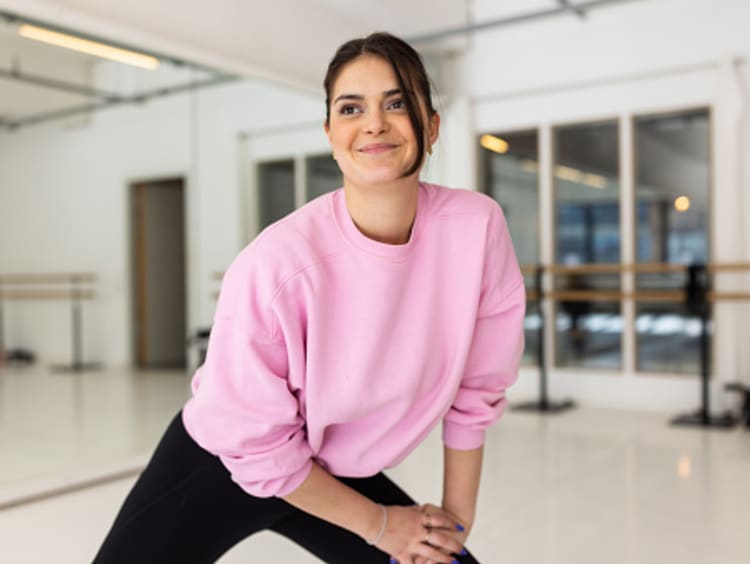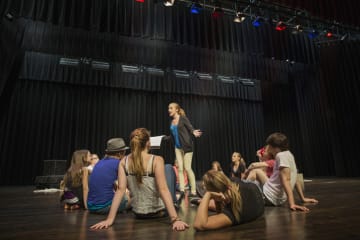Why Dance Warmups Are So Important

Every dancer should understand the importance of warming up. A well-executed warmup will prepare your body for the activities ahead, whether it's before a lesson, audition, competition or performance.
It's tempting to skip the warmup or rush through a few stretches, but your body will benefit from a comprehensive warmup. Warming up helps you prepare for the physical and mental exertion that the upcoming class will put you through. An effective warmup increases heart rate and gets your blood pumping, decreasing the chances of injury. If you want to have a career as a professional dancer, it is important that you take care of your body.
What Is Important to Warm Up for Dance?
Because dancers use their entire bodies, it is important that most every muscle be stretched and warmed up before engaging in any activity. Some essential parts of the body that one should pay special attention to include the neck, shoulder, hips and ankles.
It also might depend on what one is working on that day. If a dancer is focusing on leaps, it is important that their whole body be warmed up, but they should focus especially on the ankles and hips. One should also take time to mobilize joints to open up ankle joints, hip joints, shoulder joints and the spine.
Preparing the Body for Movement
As soon as you get into the studio, find a place where you have room to prepare your body for movement. The first thing you can do is tune your body into your breath.
Start with some diaphragmatic breathing or “belly breathing.” If you have never practiced this kind of breathing before, it is helpful to think of it in a visual way. Imagine your belly is a balloon filling up with air as you breathe in, and then deflating as you exhale. During diaphragmatic breathing, your stomach should noticeably rise and fall as you expand your stomach for the inhale. Focusing on your breath is a great way to connect your mind and body.
Then begin loosening up your joints. Due to the increased flow of synovial fluid lubricating the joints, suppleness and joint range of motion are improved as muscles lengthen. Rolling your ankles, wrists, shoulders and neck will lubricate the joints and get them ready for movement.
Additionally, another tool used for warming up is lying in your ‘X’ position on the floor. This is a great place to start with the breathing exercises. Feel the ends of your fingertips, feet and head stretching as far away from the center of your body as possible and then crunch everything into a ball in the center of your body. This will help you to get a feel for expanding and contracting.
Finally, it is a good idea to complete some heel rocks and leg swings in this position on the floor. During heel rocks, your head should also be nodding up and down. You can perform the leg swings at whatever speed your body feels ready for or let it gradually get faster. Ensure that your shoulders stay grounded into the floor and that your upper body stays stable in the center as you move from side to side.
Head to Toe Dance Warmup
First, you will want to loosen up your joints and muscles. This helps prevent injuries by increasing the blood flow and making sure it reaches all parts of the body. It also helps your muscles move more effectively for the rest of the class. Think of this as continuous stretching.
The point of this part of a warmup is to keep your body moving. This may include jumping jacks, head or shoulder rolls, plies, alternating lunges, etc. Then, we will focus on stretching our entire body from head to toe. This will include holding positions for a period of time to ensure an effective stretch. This helps to lengthen all the muscles, which will result in great flexibility as time goes on. This part of the warmup should be done last, after you have already gotten your body moving and your blood pumping.
Focus on stretching the major muscle groups, such as the hamstrings, hip flexors, shoulders, quadriceps and the trapezius. Some examples of this warmup would include holding a lunge, splits, downward dog, touching your toes or a butterfly stretch. It is important that your muscles be fully warm before executing splits to prevent injury.
How Long Should My Dance Warmup Last?
The length of a warmup will depend on a dancer’s individual needs. Some dancers require a long warmup to ensure that their bodies are as prepared as possible for dancing and to reduce the risk of injury. The length of the warmup, and which warmup exercises should be executed, will also depend on what activities or movements you will be performing.
Dancers should arrive 10 to 15 minutes early to warm up the parts of their bodies they need to. The dynamic portion of your warmup should last no less than five minutes. The length of your warmup will be determined by your present level of fitness. You must ensure that the warmup elevates your heart rate without exhausting you; you must find your happy medium.
Importance of a Dance Warmup
Warming up properly may help you avoid getting hurt. If your muscles aren't warm, you're more likely to strain or pull something in dance. It's not worth the danger of getting hurt and having to take time off to heal.
Warming up thoroughly before dancing can also help you mentally prepare for dancing. If you get into the habit of doing certain warmups before you begin dancing, not only your body — but also your mind — will be ready to dance. Being diligent with your warmup routine will set you up for a long and healthy career as a dancer.
Do you want to pursue a career in dance? Explore Grand Canyon University’s College of Arts and Media and the Bachelor of Arts in Dance degree program. Click on the Request Info button to get more information and learn how to join an amazing community of dance students.
Approved by the Director of Dance of the College of Arts and Media on Aug. 30, 2022.
The views and opinions expressed in this article are those of the author’s and do not necessarily reflect the official policy or position of Grand Canyon University. Any sources cited were accurate as of the publish date.


